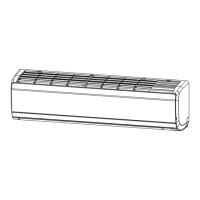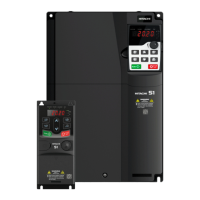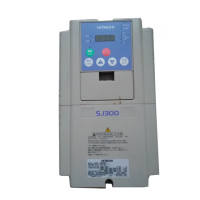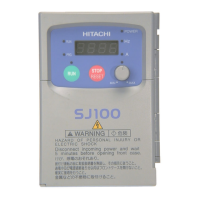For parameter configuration
[bA-30] to [bA145]
Deceleration / stop at power loss (Non-stop)
bA-30 Instantaneous
power failure non-stop
function, mode selection
00(Disable)/
01(Deceleration-stop)/
02 (Voltage controlled
decel-stop(without
recovery)) /
03 (Voltage controlled
decel-stop (with
recovery)
bA-31 Instantaneous
power failure non-stop
function, start voltage level
(400V class)
0.0 to 820.0(VDC)
bA-32 Instantaneous
power failure non-stop
function, target voltage level
(400V class)
0.0 to 820.0(VDC)
bA-34 Instantaneous
power failure non-stop
function, deceleration time
bA-36 Instantaneous
power failure non-stop
function, start frequency
decrement
bA-37 Instantaneous
power failure non-stop
function, DC bus voltage
control P gain
bA-38 Instantaneous
power failure non-stop
function, DC bus voltage
control I gain
・If the DC bus voltage of the main circuit is lower than the level of [bA-31], the
inverter decelerates to create a regenerative state.
・When [bA-30]=01, if the DC bus voltage drops under [bA-31], the current
frequency reference is decreased by [bA-36] setting and decelerates depending
on the [bA-34] setting.
If the DC bus voltage rises to the [bA-32] setting, the deceleration stops once.
・When [bA-30] = 02/03, at the time of DC bus voltage drop, deceleration is
performed to regenerate and the DC bus voltage is maintained at the [bA-32] set
value by PI control.
・During Instantaneous power failure non-stop deceleration, output terminal
023[IPS] turns ON.
Overvoltage suppression - deceleration
bA140 Overvoltage
suppression enable
setting, 1st-motor
00(Disable)/
01(Constant DC bus voltage
control(deceleration
stop))
02(Enable acceleration)/
03(Enable acceleration (at
constant speed and
deceleration))
bA141 Overvoltage
suppression active level,
1st-motor
(400V class)
660.0 to 800.0(VDC)
bA142 Overvoltage
suppression active time,
1st-motor
bA144 Constant DC
bus voltage control P gain,
1st-motor
bA145 Constant DC
bus voltage control I
gain, 1st-motor
・When [bA140] = 01, the inverter stops with the deceleration time
extended so that the DC bus voltage do not cross over the [bA141]
level.
・When [bA140] = 02, 03, the inverter accelerates once so that the DC
bus voltage do not cross over [bA141] level.
[bA146] to [bA-63]
Overvoltage suppression - Over-excitation
bA146
Over-magnetization
function selection,
1st-motor
00(Disable)/
01(Always enable)/
02(At deceleration only)/
03(Operation at setting level)/
04(Operation at setting level at
deceleration only)
bA147
Over-magnetization
function output
filter time constant,
1st-motor
bA148
Over-magnetization
function voltage
gain, 1st-motor
bA149
Over-magnetization
function level
setting, 1st-motor
(400V Class)
660.0 to 800.0(VDC)
・This function disables the AVR(Automatic output Voltage
Regulation) function, works while in over-excitation.
・This function is effective when control method
[AA121/AA221] is set 00 to 02 or 04 to 06 (V/f control).
・When [bA146]=03/04, it will be operative if DC bus
voltage exceeds [bA-149] level.
Dynamic braking (BRD) function
bA-60 Dynamic brake use
ratio
bA-61
Dynamic brake activation
selection
00(Disable)/
01(Only while running)
02(Enable during stop)
bA-62 Dynamic brake
activation level
(400V class)
660.0 to 800.0(VDC)
bA-63 Dynamic brake
resistor value
Inverter minimum
resistor value to
600(Ω)
*1) The [bA-60] setting range is
0.0 to 10.0 x [(bA-63)/(Inverter minimum resistor)]^2 (%).
・This function sets the behavior of the built-in braking
circuits.
・When using the external braking unit, these parameters
need not be set.
・Regarding the built-in braking circuit models and the
connectable minimum resistance value, refer to the
specification table in Chapter 7.

